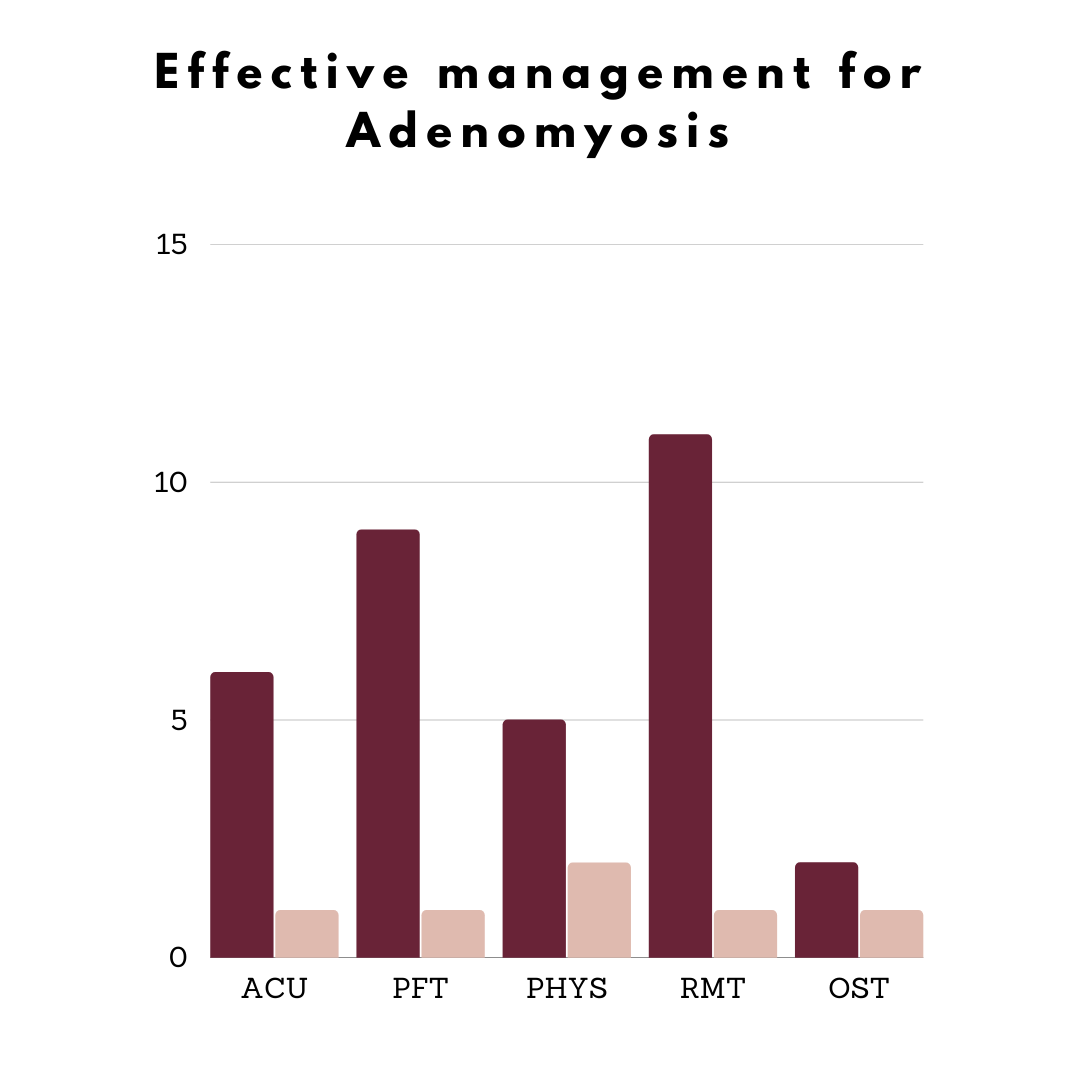ADENOMYOSIS
Definition
Adenomyosis occurs when the tissue that normally lines the uterus (the endometrium) breaks through the muscle wall of the uterus (the myometrium), affecting 1 in 10 individuals who menstruate. Those who suspect adenomyosis often experience painful periods (dysmenorrhea), heavy menstrual bleeding, abdominal bloating and pressure, pain that radiates to the lower back and down the legs.
Diagnosis and treatment of adenomyosis
Adenomyosis used to be the classic pelvic disease for multiparous women 40+ who complained of having painful periods and heavy bleeding during menstruation. A confirmatory diagnosis would be given to these women through biopsies from a hysterectomy.
Much like we see in the endometriosis community, patients and researchers alike are challenging the etiology of the disease. In parallel with advancements in medical imaging such as internal ultrasound, we are now able to find and pre-diagnosis individuals with adenomyosis, allowing them to make informed medical decisions on their reproductive organs. That being said, adenomyosis is still grossly understood, and under researched.
Since adenomyosis is also cured by hysterectomy, this likely limited both the perceived importance and the ability to further investigate the associated symptomatology, co-morbidities, and impact on quality of life. As a result, the impact of adenomyosis on women’s health has not been adequately studied. - Upson et al.
Currently, there are no drugs on the market for clinical utility of adenomyosis. Medical management for adenomyosis patients is long term and needs to address pain, bleeding and quality of life. Some patients may respond well to over the counter anti-inflammatory drugs. These can be used in combination with hormone therapy which should be used conservatively until the patient decides if and when a hysterectomy - the gold standard - should be performed. Given the age of onset for adenomyosis, the patient should be making informed decisions about the removal of reproductive organs at a young age.
Adenomyosis treatment with alternative medicine
The literature on alternative medicine therapies for pain management of adenomyosis is very limited. We don’t suspect this is because of proof or utility but because of the overall issue with resources being allocated to researching adenomyosis. For more information on data collected for general pelvic pain check out our pelvic pain page.
Survey Results
The survey data aligns very well with what we see at the clinic. Patients with adenomyosis, endometriosis and/or general pelvic pain are seeking reprieve through acupuncture, pelvic floor physiotherapy, and registered massage therapy. We suspect that with any of the variations of pelvic pain which is localized to the pelvic area, massage is being sought after for muscle relaxation and for psychological aspects of pain.
what they told us
It is clear that adenomyosis and conventional medicine modalities are not well understood. However, our survey responders seem to find reprieve with several modalities of alternative medicine. For more information see our Survey Summary.
More gynecologists are referring patients for pelvic floor physiotherapy so there is a validation of this modality through the medical system. Survey respondents indicated that pelvic floor physiotherapy has helped a lot with pain management long term. We know, from the services we offer at the clinic, tools are provided to patients for them to use in the comfort of their own home which helps them get through a flare. It is promising to see that acupuncture is already being used in this population but we hope to put forth a large education effort to make more patients are more aware of this service and its overall benefits.
Though the mechanisms are slightly different than that of endometriosis we are seeing that patients are seeking the same treatment types as our endo survey responders. Likewise, we would suggest the same approach through our centre:
If the patient is coming in for pain associated with adenomyosis, we always introduce pelvic floor physiotherapy and acupuncture to the patient. The pelvic floor physiotherapy gives us a better understanding of where the pain is located, trigger points, and other surrounding organs such as the bladder and colon that may be impacted. We then try to layer the utility of the acupuncturist who - using a combination of intake methods - can help the body channel more resources to the affected area. Frankly, the needles can be placed in a variety of combinations to achieve results. Thirdly, if the patient is amenable we do like to add in massage therapy as pelvic pain - either cyclic or chronic - can take a toll on the muscles throughout the body. This not only impacts the soreness of the muscles but can affect sleep and mood.
Adenomyosis has an inflammatory component that can me mitigated through lifestyle and dietary changes. While we did not capture this in the survey many patients find that eliminating triggers, and using high grade vitamins and supplements for pain, inflammation and hormone control can reduce symptoms and increase quality of life. Patients can find out more information about our services offered by our naturopathic doctor.
Lastly, we understand that adenomyosis is grossly misunderstood. We offer psychotherapy to address some of the root causes of stress, and stress management. We also offer peer support for a more casual mental health support outlet as well as virtual group support sessions to help build a community.
References
Epidemiology of Adenomyosis https://www.ncbi.nlm.nih.gov/pmc/articles/PMC7927213/
Recent advances in understanding and managing adenomyosis https://www.ncbi.nlm.nih.gov/pmc/articles/PMC6419978/


